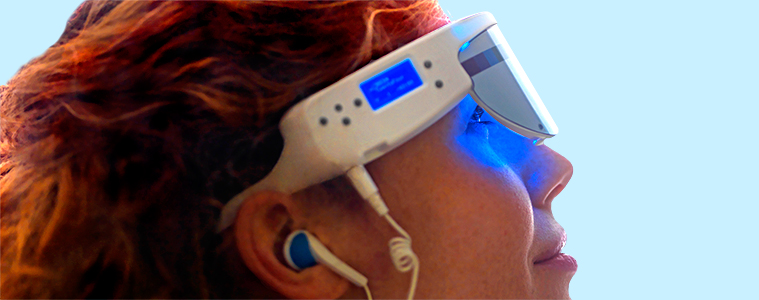free your mind |
ResearchLuminotherapy |
Drowsy drivingBlue light proven to be as effective as coffeeResearchers at the “Sleep, focus and neuropsychiatry” laboratory (CNRS / Université Bordeaux Segalen), in collaboration with Swedish scientists, have recently demonstrated for the first time, by testing in real world driving, that a continuous emission of blue light is as effective as coffee to improve alertness and driving at night. Published in the journal PLoS One, these findings could lead to the development of an anti-drowsiness system embedded within the vehicle... Before this, scientists must test more broadly this device. Induced by sleep deprivation, drowsy driving at night reduces alertness, reflexes and visual perception of the driver. It is the source of one third of fatal accidents on motorways. Besides the possibility of making a nice "POWER NAP" thanks to the light emitted by the PSiO and avoid often fatal accidents on the highway, the PSiO is therefore also an alternative to taking coffee or other stimulants that include biochemical with adverse side effects to health. We know that blue light increases alertness by stimulating special nerve cells in the retina, localized at the back of the eye membrane: the retinal ganglion cells (RGCs). These cells are connected with the brain areas controlling wakefulness. Their stimulation by blue light induces the inhibition of melatonin secretion, the hormone responsible for the decreased alertness at night. The positive effect of blue light on the nocturnal vigilance is known since 2005, thanks to American researches. But these studies have demonstrated this effect only in simple cognitive tasks, such as pressing a button when a light stimulus is perceived. Driving is a much more complex task. To investigate the effectiveness of blue light during night driving, the researchers introduced into the cockpit of an experimental vehicle, a special LED lamp mounted on the central dashboard, and emitting a continuous blue light. Then they asked 48 healthy male volunteers with average age of 33.2 years to drive for 3 nights each spaced at least by a week, 400 km on the highway. Those driving experiments were always held between 1am and 5.15 am with a 15 minute break at the halfway point. During each of the three nights, each volunteer received either continuous exposure of blue light, two cups containing 200 mg of caffeine (one before departure and one during the break), two cups of decaffeinated coffee (placebo). It is important to note that their sleep after driving under continuous blue light emission was not affected. The researchers then examined a criterion reflecting the decrease in vigilance which were the number of inappropriate crossing lateral lines (emergency line and overtake line). Result: it was found that the average number of inappropriate crossings was 15 with blue light, 13 with coffee and 26 with placebo. Continuous exposure to blue light for driving can thus be considered as effective as coffee to fight against drowsy driving, in case of course if the driver is not bothered by the light. In fact 8 of 48 volunteers (17%) were dazzled by the blue light and could not perform the test. Scientists are now stepping up to check whether these initial results reproduce on a larger number of men, but also women and the elderly. One application could be the design of an anti-drowsiness system embedded within the vehicle. Easy to imagine that the implementation of such anti-drowsiness system will take time for manufacturers to develop. Moreover, the power nap effect of the PSiO is not limited only to the projection of blue light (with the right frequency to 470 nm) but it also offers an immediate peace of mind and a true rest to the user's attention and brain area specialized in monitoring driving known to be particularly tiring when it comes to driving for several hours, or more than 5 hours ! So use the PSiO during long car trips and especially during long journeys that take you on vacation ! ReferencesIn-Car Nocturnal Blue Light Exposure Improves Motorway Driving: A Randomized Controlled Trial. Jacques Taillard, Aurore Capelli, Patricia Sagaspe, Anna Anund, Torbjorn Akerstedt, Pierre Philip. PLoS One, 19 octobre 2012. |
